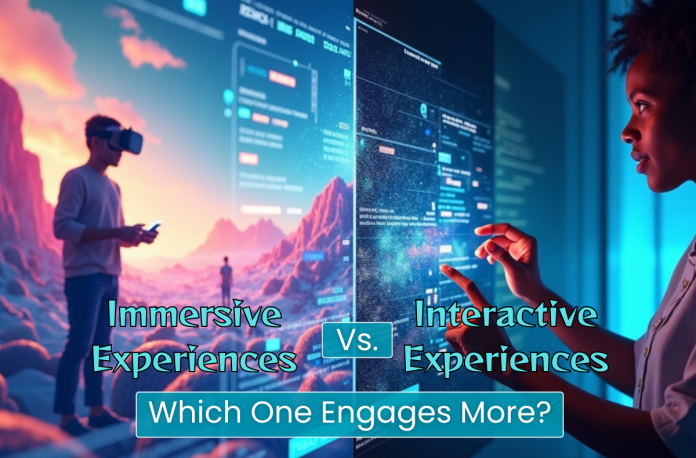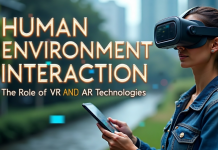In this generation of digital saturation, achieving superior user retention is not solely a function of technological novelty but of the strategic paradigm governing the user’s presence and action. At the fundamental level of experience design, immersive experiences prioritize sensory depth and ‘being there’, while Interactive experiences emphasize user agency, control, and feedback loops. The determination of superior, measurable engagement is settled not by creative novelty, but by aligning the design paradigm with the user’s cognitive objectives and the strategic application’s required fidelity.
For UX designers, digital strategists, and product teams aiming to build scalable, high-ROI digital products, a critical, evidence-based assessment is essential. This strategic analysis will quantitatively compare the respective impacts on cognitive load and retention rates, contrast the optimal design inputs required for high visual fidelity vs complex state logic, and map the strategic rationale for selecting the optimal paradigm across various key industry verticals (e.g., training, data visualization).
This blog serves as the essential strategic blueprint for making evidence-based decisions that guarantee superior user engagement and measurable project ROI.
Key Takeaways
- User retention relies on immersive and interactive experiences, but they serve different purposes: immersion enhances presence while interactivity emphasizes agency.
- Strategic analysis helps designers choose between visual fidelity and complex state logic based on their project’s goals.
- AI can elevate immersive experiences by personalizing content and dynamically responding to user actions, creating engaging environments.
- Evaluate whether to prioritize immersion or interactivity based on your business objectives to achieve better outcomes in training and engagement.
- The right balance of immersive experiences and interactivity boosts user engagement and ensures a successful digital product.
Table of Contents
How Immersion and Interactivity Affect How We Think?
Have you ever wondered why some apps or training programs stick with you, while others feel like a chore? It often comes down to two key ideas: immersion and interactivity. As a strategic designer, you need to treat these as two separate levers you can pull to boost engagement. The effectiveness of immersive experiences hinges on how well these concepts are utilized. It’s easy to confuse them, but they do very different things for your audience.
The True Difference Between ‘Being There’ and ‘Being in Control’
An immersive experience is all about Presence. It focuses on deep sensory input to make you feel like you are physically transported to another place. This is the power of being there. Think of putting on a VR headset and suddenly standing on Mars. That is a high presence.
Interactivity is all about Agency. It means you are in control, and it is the power of action and consequence. It is when your input makes the system react right away. Think of pressing a button in a training app and seeing a score immediately change.
A classic example proves they are different. A beautifully filmed 360-degree nature documentary is highly immersive but offers zero interaction. Meanwhile, a simple text-based quiz is highly interactive but offers no immersion. The most powerful experiences, the ones that truly engage, successfully combine the presence of immersive environments with the agency of action.
Why Deep Immersive Experiences Can Actually Lower Mental Strain?
Many people assume the complex visuals of immersive tech actually tire your brain out. But sometimes, the opposite is true.
High immersion, especially in a properly designed immersive virtual reality setting, can lower something called extraneous cognitive load. That big phrase means “unnecessary mental effort.“
Your brain works hard to translate a 2D screen image into a usable 3D world in your mind. That is unnecessary mental effort. When you use a high-fidelity immersive environment, your brain skips that effort because the environment already feels natural and genuine. That saved mental capacity is then focused entirely on the task at hand. This means people pay closer attention and enjoy learning more.
This cognitive efficiency is why a truly immersive experience is strategically valuable for complex training.
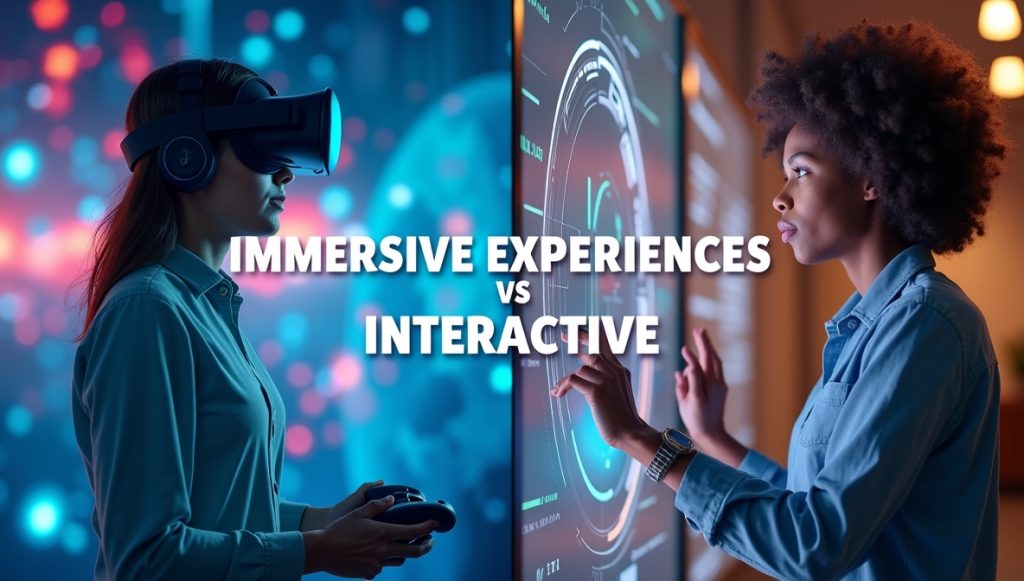
What Are the Biggest Trade-offs in Development Cost and Design?
When you are planning a high-ROI digital product, you have a crucial choice to make: where to put your development money. Should you chase the better graphics or the most complex rule systems? This is the trade-off designers face.
The choice is usually between Fidelity and State Logic.
Why Interaction Logic Costs More Than Realistic Graphics?
The cost hierarchy of development is a significant strategic insight that many beginners miss. For product designers, understanding the actual financial investment required for high-fidelity immersive experiences is critical. Suppose you want a basic 3D immersive experience that shows off a space. In that case, the development cost might be relatively low, around $50,000 to $70,000 for a standalone, non-gaming virtual reality immersive experience.
This immersive experience prioritizes visual assets, textures, and scene optimization. The developers are spending time ensuring the physics and visuals are perfect, making it feel like a real virtual experience.
However, the cost jumps significantly once you introduce complex interactivity. For a persistent, multiplayer, highly interactive digital experience that can track every user decision and synchronize data, the cost can soar to $150,000 to $200,000.
Why the huge difference?
It is the State Logic. Interactivity requires complex coding to manage every possible branching path, user input, and data storage. The biggest hurdle for high-end VR immersive experiences is not the graphics; it is building the sophisticated logic required for meaningful user agency.
The Spectrum of Experience Technology
Not all extended reality (XR) requires a large headset. Strategic use of technology depends on your deployment target.
- High Immersion/High Cost: Full-immersive VR setups using headsets provide the most profound sense of presence, ideal for surgery training or military simulations.
- Accessible Immersion: Immersive augmented reality experiences (like apps on a smartphone) are cheaper to deploy and reach a wider audience.
- Web-Based Interaction: Platforms supporting virtual reality web experiences are the most accessible, perfect for high-traffic campaigns where interaction metrics are key. This decides what is an immersive experience, more about defining the level of sensory input than the device itself.
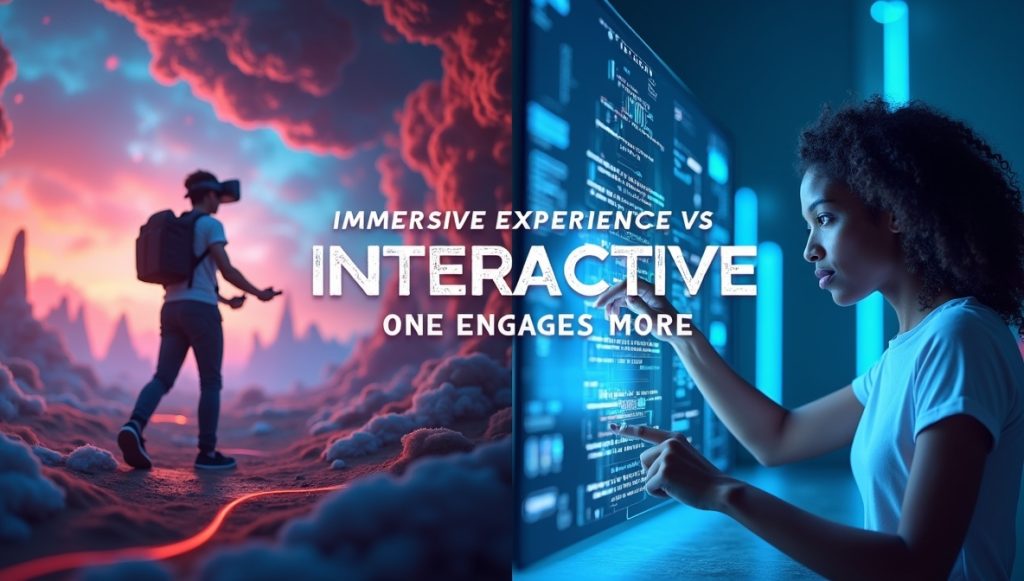
How to Know When Immersive Experiences or Interaction Is the Right Choice?
The strategic answer to “Which engages more?” is the one that best serves your business goal. You must align the experience with the specific outcome you want to measure.
Prioritize Immersive Experiences When Behavior Change is Needed
If your goal is physical skill transfer, reducing errors, or creating a powerful emotional memory, immersion wins. This is where immersive experience technology shines.
- High-Risk Training: An immersive learning experience replicates real-life scenarios, allowing safe failure. Immersive experience companies use VR immersive training to teach staff complex procedures without real-world risk. Walmart, for example, successfully reduced training time by 96% using this method, proving the robust ROI of immersive experiences.
- Context and Scale: For marketing, immersive applications are crucial for creating a connection. IKEA’s AR app is a prime example of an immersive VR solution that allows customers to virtually place furniture in their own homes, giving them a real sense of context before they buy. Similarly, Sephora uses immersive augmented reality experiences for virtual makeup try-ons, enhancing customer interaction.
Prioritize Interactivity When Data and Decisions Are Key
If your goal is to track decision paths, facilitate complex group critique, or analyze data input, interactivity is the focus.
- Collaborative Learning: Interactive solutions facilitate learning through group discussions, debates, and joint exercises. Participants actively critique strategies and propose solutions, which leads to richer learning outcomes than simple passive lessons. These types of virtual experiences are often found in business courses.
- Data Dashboards: For real-time analysis, such as monitoring building occupant flow or toggling data visualizations, a highly interactive digital experience is necessary. The focus is on the user’s ability to manipulate information instantly.
Choosing the Right Focus for Your Project
The most successful digital projects select their focus intentionally. Use this framework to guide your decision:
| Business Goal | Dominant Approach | Why It Works Best | Core Success Metric |
|---|---|---|---|
| High-Risk Training | Immersive experiences (VR/AR) | Allows safe, repeatable failure and increases knowledge retention by up to 70% | Reduction in errors and increased task speed |
| Sales & Branding | Immersive applications (AR) | Creates emotional resonance and allows pre-purchase visualization of the product | Dwell time, unique users, conversion rates |
| Complex Analysis | Interactive (Dashboards/Web) | Ideal for immediate user input and real-time data processing | Custom events (clicks, choices) and flow completion rates |
| Collaborative Output | Interactive (Web/Social) | Facilitates discussion, critiques, and joint problem-solving | Learner completion data and self-efficacy scores |
Making Experiences Smarter with AI Integration
The cutting edge of engagement strategy is not just about immersion or interactivity alone, but how they work together, constantly adapting to the user. This is the role of Artificial Intelligence. AI is the engine that moves us beyond pre-programmed content to truly dynamic and responsive immersive applications.
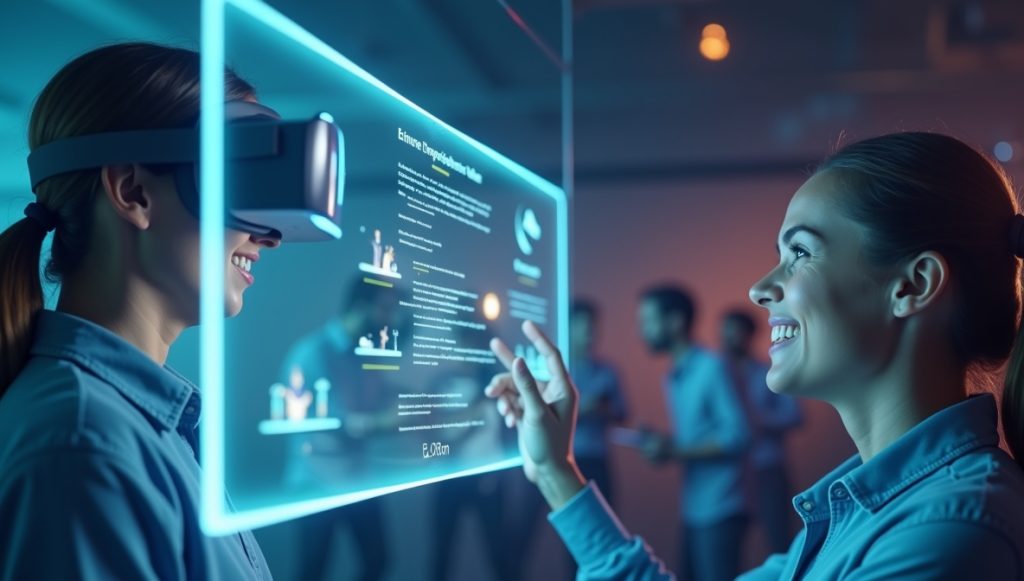
How AI Creates the Ultimate Immersive Experiences?
AI dramatically enhances the quality of a 3D immersive technology setup. It allows the system to generate or modify visuals, audio, and narratives instantly in response to the user.
This dynamic adaptability heightens the user’s emotional connection and sense of realism. When the virtual environment constantly adjusts itself, the illusion of presence is harder to break.
- Dynamic Graphics: AI helps generate realistic 3D models and optimize textures, creating stunning AI-immersive experiences.
- Adaptive Sound: AI and immersive experiences can drive dynamic soundscapes that change based on what the user is doing, making the immersive environment feel genuinely alive.
AI Personalizes Agency for Better Engagement
The most powerful feature of AI and immersive experiences is its ability to learn from user actions and offer predictive personalization. AI analyzes the data captured from interactivity to anticipate what you need next.
- Predictive Rewards: By analyzing user behavior, AI can offer tailored content, adjust difficulty in training, or give predictive rewards based on playing style.
- Intelligent Assistants: Platforms like Google’s Android XR are integrating AI, allowing users access to virtual assistants right inside the environment. This paves the way for enhanced productivity and highly personalized training experiences using immersive VR technology.
An AI creates engaging and immersive experiences by constantly recalibrating the content. It uses the data from what you did (interactivity) to improve where you are (immersion), forming a self-optimizing loop that ensures the content remains maximally engaging for you personally. If you are building a high-volume immersive experience, companies need to adopt this strategy. This provides true personalization at scale, which is essential to making the immersive experiences truly valuable. This ensures every user gets the maximum benefit from their immersive experiences.
Conclusion
When deciding between high immersion or high interactivity, remember the core principles: it is not a competition; it is a synthesis.
You must first define your primary business objective. If the goal is rapid skill acquisition, emotional branding, or high-fidelity visualization, prioritize the sensory depth of immersive experiences. If the goal is collaborative discussion, complex decision-making, or real-time data input, prioritize the complex logic and feedback loops of interactivity.
The highest ROI is found in the sweet spot where your audience feels fully present and their actions truly matter. By strategically choosing the right balance for your budget and goal, you ensure your next digital product delivers superior user engagement and measurable financial success. You now have the blueprint to make that confident decision for any project that involves an immersive VR experience.
FAQs
The primary difference lies in the user’s role. Immersive experiences prioritize Presence, making you feel like you are physically “there” through high sensory input. Interactive experiences prioritize Agency, giving you control and allowing your actions to influence the outcome.
A great example of an immersive experience is a surgical training simulation that uses a VR immersive headset. It fully replicates the operating theatre, making the student feel present. This sense of realism is crucial for practicing complex procedures safely.
An immersive experience improves customer engagement by creating emotional resonance, which increases attention and enjoyment. For learning, the enhanced sense of presence can also lead to higher knowledge retention, sometimes up to 70% better than traditional methods. This makes immersive experience technology a powerful tool.
AI creates engaging and immersive experiences by adding dynamic personalization. AI analyzes how a user is interacting with the system and instantly adjusts the content, difficulty, or narrative. This prevents the experience from feeling static, ensuring it remains perpetually relevant and highly engaging for the individual user.
No, not always. While an immersive VR experience delivers superior presence for deep training, a simple 3D web experience is often more cost-effective for mass distribution. It is better for projects needing broad accessibility, lower development budgets, and high volumes of behavioral tracking data. The best choice depends entirely on your project’s goals.



